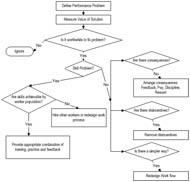 |
| Performance Consulting | Marketing and Communications | Methods, Tools and Software |
|
© Daniel Follette, Inc. 2025
|
|
|
| Identifying
and eliminating performance discrepancies
Methods
and software to define, document, analyse and assign work Our
goal is to provide a clear picture of a process, so that it can
be optimized and effectively communicated. That same clear picture
enables companies to assign and track accountability. Our goal is to create enthusiastic employee acceptance of new programs and continued engagement. Effective roll out and training means employees are competent in performing their tasks. |
| work
analysis > Behavioral analysis |
| task
analysis software > SkillForge™ Work Analysis software |
| performance
management ERP > Performance Information Systems |
| enterprise
strategies > Strategic Repertoire Development™ |
| >
Strategic Resource Allocation™ |
| > Skill-based pay |
| > Competencies |
|
procedures
strategies
> Procedures management |
|
> SkillForge™
Procedures software |
|
case
studies > Selected cases |
| thought
leadership > White papers |
| resources > Additional resources |
